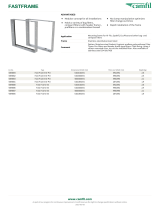
2.4.3 Danfoss Frequency Converter and CE Labelling
CE labelling is a positive feature when used for its original purpose, i.e. to facilitate trade within the EU and EFTA.
However, CE labelling may cover many different specifications. Thus, you have to check what a given CE label specifically covers.
The covered specifications can be very different and a CE label may therefore give the installer a false feeling of security when using a frequency converter
as a component in a system or an appliance.
Danfoss CE labels the frequency converters in accordance with the low-voltage directive. This means that if the frequency converter is installed correctly,
we guarantee compliance with the low-voltage directive. Danfoss issuesWe issue a declaration of conformity that confirms our CE labelling in accordance
with the low-voltage directive.
The CE label also applies to the EMC directive provided that the instructions for EMC-correct installation and filtering are followed. On this basis, a
declaration of conformity in accordance with the EMC directive is issued.
The Design Guide offers detailed instructions for installation to ensure EMC-correct installation. Furthermore, Danfoss specifies which our different prod-
ucts comply with.
Danfoss provides other types of assistance that can help you obtain the best EMC result.
2.4.4 Compliance with EMC Directive 89/336/EEC
As mentioned, the frequency converter is mostly used by professionals of the trade as a complex component forming part of a larger appliance, system,
or installation. It must be noted that the responsibility for the final EMC properties of the appliance, system or installation rests with the installer. As an
aid to the installer, Danfoss has prepared EMC installation guidelines for the Power Drive system. The standards and test levels stated for Power Drive
systems are complied with, provided that the EMC-correct instructions for installation are followed, see the section
EMC Immunity
.
The frequency converter has been designed to meet the IEC/EN 60068-2-3 standard, EN 50178 pkt. 9.4.2.2 at 50°C.
2.5.1 Aggressive Environments
A frequency converter contains a large number of mechanical and electronic components. All are to some extent vulnerable to environmental effects.
The frequency converter should not be installed in environments with airborne liquids, particles, or gases capable of affecting and
damaging the electronic components. Failure to take the necessary protective measures increases the risk of stoppages, thus reducing
the life of the frequency converter.
Liquids can be carried through the air and condense in the frequency converter and may cause corrosion of components and metal parts. Steam, oil, and
salt water may cause corrosion of components and metal parts. In such environments, use equipment with enclosure rating IP 54/55. As an extra
protection, coated printed circuit boards can be ordered as an option.
Airborne
Particles such as dust may cause mechanical, electrical, or thermal failure in the frequency converter. A typical indicator of excessive levels of
airborne particles is dust particles around the frequency converter fan. In very dusty environments, use equipment with enclosure rating IP 54/55 or a
cabinet for IP 00/IP 20/TYPE 1 equipment.
In environments with high temperatures and humidity,
corrosive gases such as sulphur, nitrogen, and chlorine compounds will cause chemical processes
on the frequency converter components.
Such chemical reactions will rapidly affect and damage the electronic components. In such environments, mount the equipment in a cabinet with fresh
air ventilation, keeping aggressive gases away from the frequency converter.
2 Safety and Conformity FC 300 Design Guide
14
MG.33.BC.02 - VLT
®
is a registered Danfoss trademark
2






















